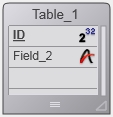Tech Tip: Utility method to get primary key field pointers of a table
PRODUCT: 4D | VERSION: 15.1 | PLATFORM: Mac & Win
Published On: June 23, 2016
Below is an utility method to retrieve the pointers to the primary key fields of a given table. A second paramater of a pointer to an pointer array can be passed for composite primary keys.
Example:
Given the following table:

The primary key for the table is the "ID" field. The following code can be ran to programmatically retrieve the field pointer:
Below is a table with a composite primary key. The primary key fields are ID1, ID2, and ID3:

Running the following code will retrieve three pointers to the field in the $arrPks array.
Below are the results of running the code:

| // Method: UTIL_GET_TABLE_PK // Returns pointer to primary key field(s) of a given table // // Parameters: // $1 - Pointer to table // $2 - Pointer to an array of pointers to contain primary key fields (OPTIONAL) // $0 - Returns pointer to field that is primary key C_POINTER($1;$tblPtr;$0;$pkPointer) C_LONGINT($tblNum;$i) C_TEXT($cID) If(Count parameters>=1) $tblPtr:=$1 $tblNum:=Table($tblPtr) ARRAY TEXT($constrIDs;0) Begin SQL Select CONSTRAINT_ID from _USER_CONSTRAINTS Where Table_ID=:$tblNum AND CONSTRAINT_TYPE='P' Into :$constrIDs End SQL ARRAY LONGINT($colIDs;0) ARRAY TEXT($colNames;0) For ($i;1;Size of array($constrIDs)) $cID:=$constrIDs{$i} Begin SQL Select COLUMN_ID, COLUMN_NAME from _USER_CONS_COLUMNS Where Table_ID=:$tblNum AND CONSTRAINT_ID=:$cID Into :$colIDs, :$colNames End SQL End for if(Size of array($colIDs)>=1) $pkPointer:=Field($tblNum;$colIDs{1}) $0:=$pkPointer End if If (Count parameters>=2) C_POINTER($2;$arrPKs) $arrPKs:=$2 For ($i;1;Size of array($colIDs)) APPEND TO ARRAY($arrPKs->;Field($tblNum;$colIDs{$i})) End for End if End if |
Example:
Given the following table:

The primary key for the table is the "ID" field. The following code can be ran to programmatically retrieve the field pointer:
| $pkPtr:=UTIL_GET_TABLE_PK(->[Table_1]) //$pkPtr:= ->[Table_1]ID |
Below is a table with a composite primary key. The primary key fields are ID1, ID2, and ID3:

Running the following code will retrieve three pointers to the field in the $arrPks array.
| ARRAY POINTER($arrPks;0) UTIL_GET_TABLE_PK(->[CompositeKey];->$arrPks) |
Below are the results of running the code:

